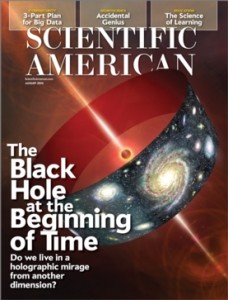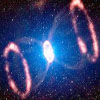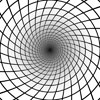Science Discovers What UN.AR.I.U.S. Has Said All Along
The Black Hole at the Beginning of Time
by Niayesh Afshordi, Robert B. Mann and Razieh Pourhasan
-August 2014, Scientific American, 38-39, 43
Excerpt per Fair Use:
“IN HIS ALLEGORY OF THE CAVE, THE GREEK PHILOSOPHER PLATO DESCRIBED prisoners who have spent their entire lives chained to the wall of a dark cavern. Behind the prisoners lies a flame, and between the flame and prisoners parade objects that cast shadows onto a wall in the prisoners’ field of view. These two-dimensional shadows are the only things that the prisoners have ever seen-their only reality. Their shackles have prevented them form perceiving the true world, a realm with one additional dimension to the world that they know, a dimension rich with complexity and-unbeknownst to the prisoners-capable of explaining all that they see. Plato was on to something.
We may all be living in a giant cosmic cave, created in the very first moments of existence. In the standard telling, the universe came into being during a big bang that started from an infinitely dense point, but according to recent calculations that we have carried out, we may be able to track the start of the universe back to an era before the big bang-an era with an additional dimension of space. This protouniverse may have left visible traces that upcoming astronomical observations could uncover.
The universe appears to us to exist in three dimensions of space and one of time-a geometry that we will refer to as the “three-dimensional universe.” In our scenario, this three-dimensional universe is merely the shadow of a world with four spatial dimensions. Specifically, our entire universe came into being during a stellar implosion in this suprauniverse, an implosion that created a three-dimensional shell around a four-dimensional black hole. Our universe is that shell.
Why would we postulate something that sounds, on the face of it, so absurd? We have two reasons. First, our ideas are not idle speculation-they are firmly grounded in the mathematics that describe space and time.
Over the past couple of decades physicists have developed a rich theory of holography, a set of mathematical tools that allows them to translate descriptions of events in one dimension to the physics of a different dimension. For example, researchers can solve relatively straightforward equations of fluid dynamics in two dimensions and use those solutions to understand what is going on in a much more complicated system-for example, the dynamics of a three-dimensional black hole. Mathematically, the two descriptions are interchangeable-the fluid serves as a perfect analogue for the extraordinary black hole.
The success of holography has convinced many scientists that more is at work here than a simple mathematical transformation. Perhaps the boundaries between dimensions are less stable than we thought. Perhaps the rules of the cosmos are written in another set of dimensions and translated into the three we perceive. Perhaps, like Plato’s prisoners, our personal circumstances have tricked us into believing the world is three-dimensional when in fact a deeper understanding of what we perceive will come only when we look for explanations in the fourth dimension.
The second reason that our four-dimensional universe is worth thinking about is because a close study of this universe could help us understand deep questions about the origin and nature of the cosmos. consider, for example, the big bang, the primordial flash that brought our universe into existence. Modern cosmology holds that the big bang was immediately followed by “inflation”-period of rapid expansion of space in which the early universe increased its volume by a factor of 10 to the 78 (or more). Yet this expansion provides no insight into what caused the big bang. Our four-dimensional universe, in contrast, gives us an answer to the ultimate mystery. Where did the universe come from?
THE KNOWN AND UNKNOWN COSMOS
Our investigations into the four-dimensional universe came about because of the problems that we have had contemplating the three-dimensional one. Modern cosmology has been fantastically successful, but its successes belie deep and complex mysteries that may lend themselves to a holographic explanation.
Cosmologists can describe the history of the entire universe-from the present day all the way back to a fraction of a fraction of a second after the big bang-using only a few equations (chief among them the ones provided by Albert Einstein) and five independent numbers, or parameters. These parameters include the densities of ordinary matter, dark matter and dark energy, along with the amplitude and shape of quantum fluctuations in the early universe. This model-the Lambda Cold Dark Matter (A-CDM) cosmological paradigm-describes hundreds (if not thousands) of observational data points, covering scales from a million light-years to 10 billion light-years across, right up to the edge of our observable universe, but these observational successes do not mean our task is complete. The story of the universe is pocked with troublesome holes. We are confronted by fundamental questions about the nature of the cosmos-problems that we have not, as of yet, been able to answer.
EXTRADIMENSIONAL COLLAPSE
Such a cloak would differ from an ordinary event horizon in one critical way. Because we perceive that our universe has three spatial dimensions, the event horizon that cloaks the singularity at the heart of the big bang must also have three spatial dimensions-not just two. If we imagine that this event horizon also came about as a result of a cosmic collapse-just as a black hole’s two-dimensional star-then the collapse would have to take place in a universe with four spatial dimensions.
This kind of extradimensional scenario in which the number of dimensions of space exceeds the obvious three, is an idea almost as old as general relativity itself. It was originally proposed by Theodor Kaluza in 1919 and expanded by Oskar Klein in the 1920s. Their idea was largely forgotten for more than half a century before being picked up by physicists studying string theory in the 1980s. More recently, scientists have used it to build a cosmology of so-called brane worlds.
The basic idea of a brane world is that our three-dimensional universe is a subuniverse embedded in a larger space of four or more spatial dimensions. The three-dimensional universe is called a brane, and the larger universe is called the bulk. All known forms of matter and energy are stuck to our three-dimensional brane like a movie projected on a screen (or the shadow reality for Plato’s prisoners in the cave). The exception is gravity, which permeates all of the higher-dimensional bulk.
What would a four-dimensional black hole look like? It would also have an event horizon, a surface of no return from which no light could escape. But instead of a two-dimensional surface, as we have in ordinary black holes, a four-dimensional black hole would generate an event horizon with three spatial dimensions.
Indeed, by modeling the collapsing death of a four-dimensional star, we find, under a variety of circumstances, that the material ejected from the stellar collapse can form a slowly expanding three-brane surrounding this three-dimensional event horizon. Our universe is this three-brane – a hologram of sorts for a four-dimensional star collapsing into a black hole. The cosmic big bang singularity becomes hidden to us-locked forever behind a three-dimensional event horizon.
IS THIS REAL?
Our model has a number of things going for it, starting with the fact that it eliminates the naked singularity that gave rise to the universe. but what of the other long-standing cosmological problems, such as the near flatness and high uniformity of the cosmos? Because the four-dimensional bulk universe could have existed for an infinitely long time in the past, any hot and cold spots in the bulk would have had plenty of time to come to equilibrium. The bulk universe would be smooth, and our three-brane universe would inherit this smoothness. In addition, because the four-dimensional black hole would also appear to be nearly featureless (or without “hair”), our emergent three-brane universe would likewise be smooth, the larger the mass of the four-dimensional star, the flatter the three-brane, and so the flatness of our universe is a consequence of it being residual detritus from the collapse of a heavy star.
In this way, our model of a holographic big bang resolves not only the main puzzles of uniformity and near flatness of standard cosmology without resorting to inflation but also nullifies the damaging effects of the initial singularity.
The idea may sound crazy, but there are several ways one might be able to test it. One way is by studying the cosmic microwave background radiation. Outside of our three-brane, we would expect there to be some extra four-dimensional bulk matter-something pulled close by the gravitational pull of the black hole. We can show that thermal fluctuations in this extra matter will create fluctuations on the three-brane that in turn distort the CMB by small but potentially measurable amounts. Our calculations differ from the latest data from the European Space Agency’s Planck space observatory by about 4 percent. But this discrepancy may be the result of secondary effects that we have not yet properly modeled.
In addition, if the four-dimensional black hole is spinning (it is very common for black holes to spin), then our three-brane may not look the same in all directions. The large-scale structure of our universe would appear slightly different in different directions. Astronomers may also be able to find this directionality by studying subtle variations in the CMB sky.
Of course, even as the holographic big bang resolves one giant question-the origin of our universe-it simultaneously raises a new set of mysteries. Foremost among them: Where did our universe’s parent universe come from?
For an answer to this puzzle, we might again turn to Plato. When Plato’s prisoners emerged from the cave, the light of the sun burned their eyes. It took them time to adjust to the brightness. At first, the prisoners were only able to make out shadows and reflections. Soon they could see the moon and the stars. Finally, they correctly concluded that the sun was “the author of all that we see”-day, night, season and shadow. Plato’s prisoners didn’t understand the powers behind the sun, just as we don’t understand the four-dimensional bulk universe. But at least they knew where to look for answers.”
Posted in Science For The New Agewith comments disabled.





